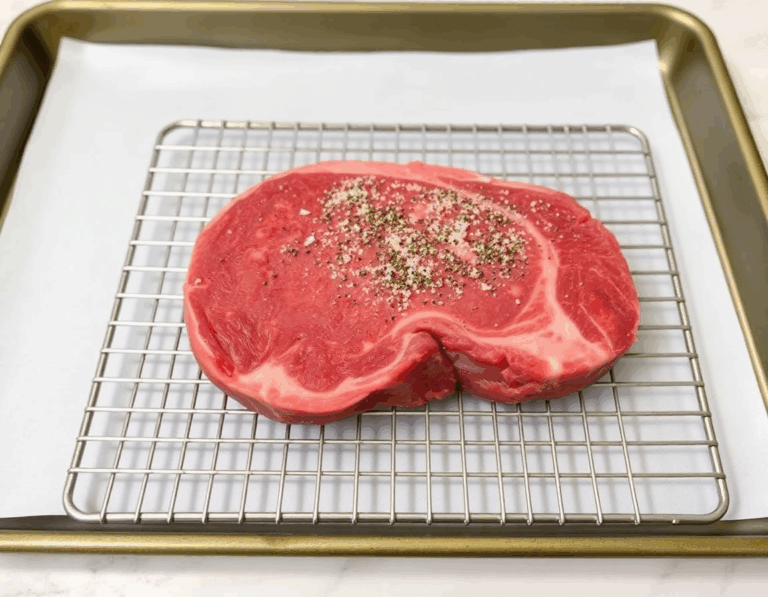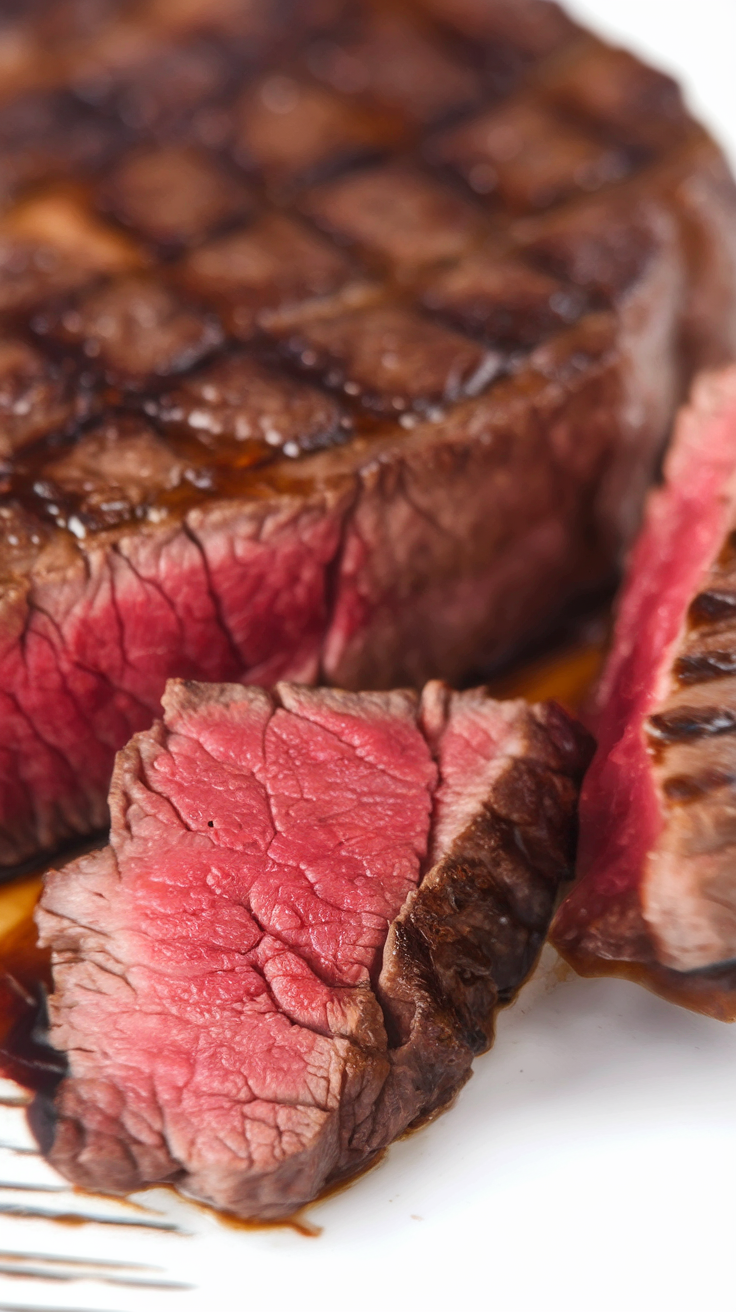There’s something almost magical about the reverse sear method—like turning a classic tune into a remix that’s even better than the original. Imagine a steak that’s both tender and juicy, with a crust so perfect it could make a food critic weep. I stumbled upon this technique during a weekend cookout, and let me tell you, it was a game-changer. If steaks were social media posts, this would be the viral hit everyone’s talking about—because who doesn’t want a steak that’s basically the Beyoncé of the culinary world?
Steps
- Generously season the steak(s) with salt and pepper. For enhanced browning, place the steak(s) on a wire rack over a rimmed baking sheet and refrigerate uncovered overnight. If you skip this step, move directly to the next stage.
- To cook in the oven, preheat it to a temperature between 200 and 275°F (93 and 135°C). Position the steak(s) on a wire rack set over a rimmed baking sheet.
- Cook the steak(s) in the oven until an instant-read thermometer shows 105°F (41°C) for rare, 115°F (46°C) for medium-rare, 125°F (52°C) for medium, or 135°F (57°C) for medium-well. This should take approximately 20 to 40 minutes, depending on your desired doneness.
- Just before removing the steak(s) from the oven, heat a tablespoon of oil in a cast iron or stainless steel skillet until it smokes. Add the steak(s) and butter, searing each side for about 45 seconds, and use tongs to sear the edges. Serve immediately, as there’s no need to let them rest.
- For grilling, light a chimney full of charcoal and spread the coals over half of the grate, or set half of a gas grill’s burners to high. Preheat the grill with the grate in place.
- Place the steak(s) on the cooler side of the grill, cooking uncovered, and turn them occasionally until they reach your desired temperature. Check frequently with an instant-read thermometer.
- Transfer the steak(s) to a platter and cover with foil. If using charcoal and the coals have dwindled, build up a strong fire. For a gas grill, turn all burners to the highest setting and preheat with the lid closed.
- Return the steak(s) to the hottest part of the grill, turning frequently until they are crisp and charred, which should take about 1 1/2 minutes. Serve immediately.

Ingredients
- seared steak recipe, with slight modifications:
- 1 to 2 beef steaks, thick-cut, each at least 1 1/2 to 2 inches thick (such as ribeye, strip, porterhouse, T-bone, tri-tip, or filet mignon)
- Kosher salt
- Freshly ground black pepper
- Vegetable oil (optional, for stovetop finishing)
- 1 tablespoon (15 g) unsalted butter (optional, for stovetop finishing)
Nutritional Values
Calories: 743 | Fat: 50g | Saturated Fat: 20g | Cholesterol: 223mg | Sodium: 487mg | Carbohydrates: 0g | Dietary Fiber: 0g | Total Sugars: 0g | Protein: 68g | Vitamin C: 0mg | Calcium: 51mg | Iron: 8mg | Potassium: 692mg
FAQ
- What is the reverse sear method for cooking steak?
- Why should I dry-brine my steak overnight before using the reverse sear method?
- brining your steak overnight helps to dry out its exterior, leading to more effective browning during the searing process. The dry surface allows for a faster and more intense Maillard reaction, which enhances the flavor and texture of the crust.
- What are the benefits of using the reverse sear method over traditional searing?
- Can I use the reverse sear method with any cut of steak?
- cut steaks, typically at least 1 1/2 to 2 inches thick. Thinner steaks may cook through too quickly, making it difficult to achieve the perfect balance of a well-seared exterior and a juicy, evenly cooked interior.
- Is sous-vide steak better than reverse-seared steak?
- vide cooking provides consistent results and is nearly foolproof, the reverse sear method excels at producing a superior crust because the steak’s surface is drier, allowing for better searing. Ultimately, the choice between the two methods depends on personal preference and the desired outcome.
Tips
- Dry-Brining for Better Browning: To enhance browning, consider dry-brining your steak by refrigerating it uncovered on a wire rack overnight. This process dries the exterior, which helps achieve a beautifully browned crust when searing.
- Monitor Temperature with a Thermometer: An instant-read thermometer is crucial for ensuring your steak reaches the desired doneness. Use it to check the internal temperature frequently, as cooking times can vary significantly.
- Minimize Surface Moisture: Before searing, ensure the steak’s surface is as dry as possible to promote rapid browning. Removing moisture allows the Maillard reaction to occur more efficiently, resulting in a crisp crust.
- Slow Cooking for Tenderness: By gradually heating your steak in a low-temperature oven, you not only allow the enzymes to tenderize the meat but also expand the window of perfect doneness, making it easier to achieve the desired result.
Equipment
- Seared Steak recipe, here is a list of main equipment that might not be typically found at home and could be purchased on Amazon:
- Instant-Read Thermometer – Essential for checking the internal temperature of the steak to ensure it is cooked to your desired level of doneness.
- Wire Rack and Rimmed Baking Sheet – Used for dry-brining the steak in the refrigerator and cooking it in the oven.
- Cast Iron Pan, Carbon Steel Skillet, or Heavy Stainless Steel Skillet – Necessary for searing the steak to achieve a crisp, brown crust.
- Charcoal Grill and Chimney Starter – If opting to cook the steak on a grill, these tools are needed for starting and maintaining the fire.

